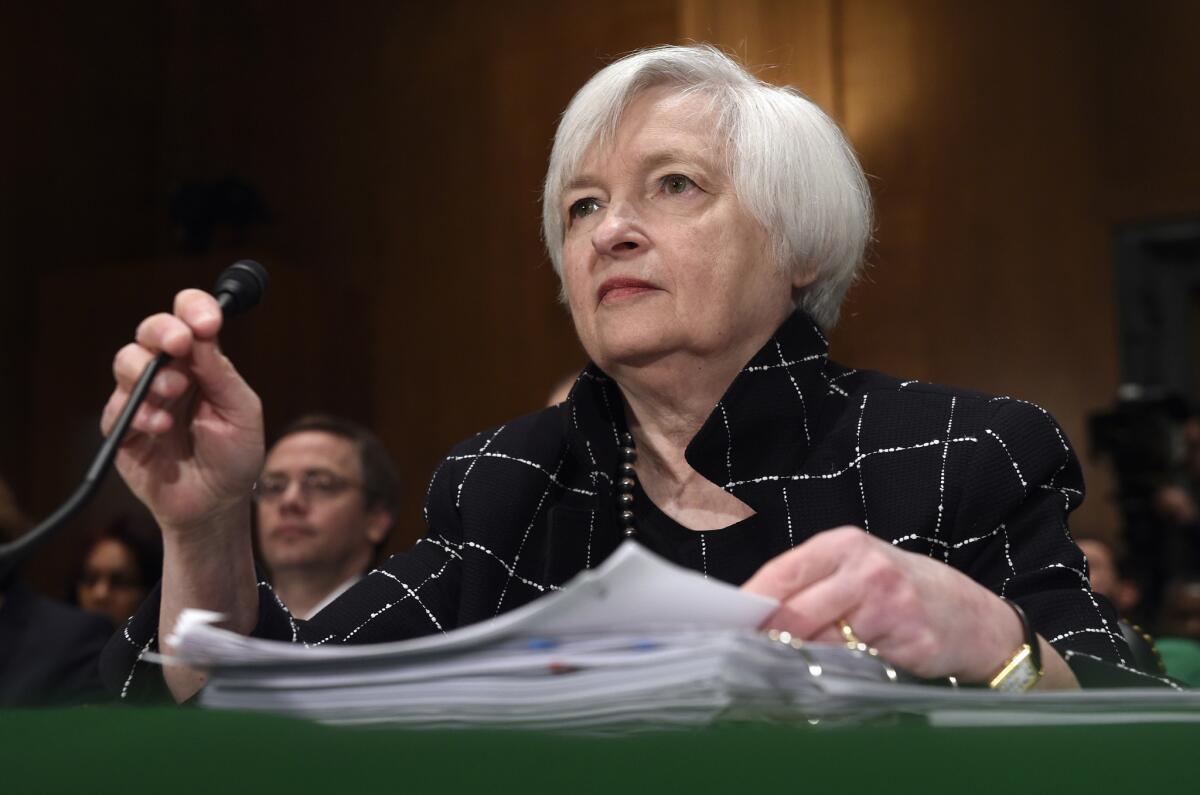What to expect from the Federal Reserve meeting

- Share via
Before the latest labor market report, there was high anticipation that Federal Reserve policymakers would inch up their benchmark interest rate this week for the second time in six months.
But surprisingly anemic job growth in May has all but eliminated any belief among analysts and investors that the Federal Open Market Committee will announce a change when it releases its monetary policy statement at 11 a.m. Pacific time Wednesday.
Still, even if conventional wisdom is correct, there should be plenty of new information – including comments from Fed Chairwoman Janet L. Yellen at her quarterly news conference – to start the speculation about whether a rate hike will come next month.
Here’s what to expect.
Holding the interest rate steady – for now
When the Fed issued its most recent forecast, in March, a majority of the 17 policymakers — including non-voting committee members — anticipated two, small 0.25-percentage-point increases this year.
That was half of the four such rate hikes forecast in December. The downgrade came after economic growth slowed sharply at the start of 2016.
But with the economy expected to bounce back in the second quarter, analysts pegged June for the next rate hike.
Then, on June 3, the Labor Department reported the economy created just 38,000 net new jobs last month. It was the worst job creation since 2010 and about 120,000 less than expected.
Three days later, Yellen signaled in a speech that Fed policymakers probably would wait a month to see if the report was an anomaly or a sign of a longer-lasting labor market slowdown.
The odds of a June rate hike have dropped from about 21% before the jobs report to 1.9%, according to a closely watched gauge by the CME Group futures exchange.
Financial markets would be shocked if the rate is raised Wednesday. And the last thing the Fed likes to do is shock the markets.
Keep your eye on the dots
Four times a year, the Fed releases a graph with dots illustrating each policymaker’s expectation for the federal funds rate at the end of the next four years and in the longer run.
Assuming the Fed sticks with 0.25-percentage-point moves, the so-called dot plot will be a good indicator of how many more increases are coming – and whether policymakers are anticipating one in July.
Fed officials have said they want to increase the rate gradually. And with only four meetings left this year after June’s, it would be hard to squeeze in two hikes if one isn’t in July and still move gradually.
So once analysts read the statement to see if the Fed is hiking the rate this month, they’ll quickly look at the dot plot to see if the forecast for the rest of the year has shifted.
Going forth in July, or see you in September
Absent a rate hike Wednesday, attention will immediately shift to a possible move at the July 26-27 meeting.
On rare occasions, the policy statement has strongly hinted of an upcoming hike. And the dot plot also has provided clues.
But the strongest signal this time probably will come from Yellen during her news conference, which begins at 11:30 Pacific time.
Expect Yellen to be pressed on the point.
A move in July could be problematic because Yellen does not have a scheduled news conference after the meeting. The next one isn’t until late September.
Analysts believe that these first few hikes after a long period of a near-zero rate are much more likely at meetings with news conferences so Yellen could explain the Fed’s rationale and calm any market jitters.
Yellen has taken pains to say that the Fed could increase the rate at any of its eight meetings each year. And Fed officials have tested a conference call system with journalists that could be used in lieu of a conventional news conference for her to explain a rate change.
So if Yellen doesn’t strongly signal a rate hike is coming next month, she’s likely to at least keep it on the table.
Waiting on the Brits
Another reason for the Fed to hold off on a rate hike this month is that British voters go to the polls next week to decide if they will remain part of the European Union.
An exit by Britain – dubbed the Brexit – would rattle world financial markets because it would cause turmoil in one of the world’s key economies and raise questions about the future of the EU.
Yellen warned in a speech last week that a British vote to leave the EU “could have significant economic repercussions.”
Recent polls have shown voters inclined to support the Brexit. And with uncertainty surrounding the referendum’s outcome and impact, Fed policymakers might decide it’s better to wait than add the fallout from a U.S. rate hike to the market mix.
Yellen said last week that the British vote “could shift investor sentiment.” Expect her to be pressed for more details on her concerns about the effects of a Brexit on the U.S. economy.
Follow @JimPuzzanghera on Twitter
Inside the business of entertainment
The Wide Shot brings you news, analysis and insights on everything from streaming wars to production — and what it all means for the future.
You may occasionally receive promotional content from the Los Angeles Times.








